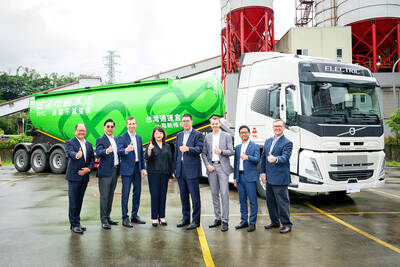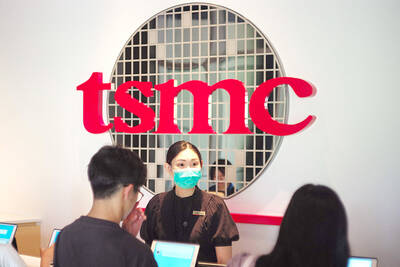This is not the first time there has been speculation about the possible merger of Taiwan’s two biggest LCD panelmakers Chimei Innolux Corp (奇美電子) and AU Optronics Corp (AUO, 友達光電) — thereby enabling it to better deal with the industrial downturn and compete with South Korean and Chinese rivals.
On Tuesday, Council for Economic Planning and Development (CEPD) Minister Christina Liu (劉憶如) met with the heads of the two companies — AUO chairman Lee Kun-yao (李焜耀) and Chimei Innolux chairman Frank Liao (廖錦祥) — to mediate a potential merger.
Despite what are only tentative plans, there has already been much opposition to the government’s plans to facilitate a merger between the two companies.
“I cannot agree with this merger,” IDC display analyst Annabelle Hsu (徐美雯) said last week. “First of all, the central problem is never the scale of capacity, but how to deal with excessive capacity, or how to add value.”
Oversupply and sluggish demand have caused a drastic decline in prices, but that will not work itself out until the second half of next year, Hsu said. Europe and the US consumed about half of global LCD TVs, Hsu said, and TV panels accounted for 70 percent of LCD panel revenues.
Liu said she believed “local LCD companies must integrate or collaborate with each other, given that the synergy created by combining capacity, technology and marketing would provide an extra edge in terms of global competitiveness.”
The CEPD even offered to create a fund to push for the AUO-Chimei merger along with extra capital from overseas investors, said Liu, who is in charge of the NT$200 billion (US$6.57 billion) National Development Fund (國發基金) that is on the verge of running out. As little as NT$20 billion is currently available.
“The optimal time for a merger has passed. Now it’s is a race about technology, not capacity. Only those companies with the best technological capability can win this game,” said David Hsieh (謝勤益), a vice president at market researcher DisplaySearch, about the proposed AUO-Chimei merger.
Lee hinted on Tuesday that AUO would not pursue a merger-and-acquisition deal to weather the downturn.
“AUO is in good shape in terms of finance, technology and talent. The company can withstand the industrial downturn,” he said
“AUO does not really need [financial] help,” said Chris Lin (林首男), a senior analyst with Daiwa-Cathay Capital Markets Co Ltd.
Although the company has lost NT$40.59 billion in the first three quarters of this year, its financial status is relatively healthy, with a debt-to-equity ratio of 35 percent. AUO also had NT$83.42 billion in cash and cash equivalents as of the end of September, as shown in its financial statement.
In addition, the AUO-Chimei merger would create limited synergy as “there is too much overlap in terms of capacity and client base, and their corporate cultures are very different,” Lin said.
For Chimei, financial support could prove sufficiently attractive for the company to start merger talks with AUO as its debt-to-equity ratio is 130 percent, Lin suggested. At the same time, Chimei also accumulated losses of NT$44.45 billion in the first nine months of the year.
Given that M&A deals can be difficult to conclude even when both parties are interested, AUO’s lack of interest bodes ill for the merger.
Hsu suggests that the Taiwanese LCD companies need financial support to accelerate their development of advanced technology in order to sharpen their competitive edge.
In contrast, Taiwanese LCD companies tend to slash spending on research and development during difficult times, which ultimately leads to loss of market share, while their South Korean rivals doubled spending to prepare advanced and better-priced products for the upturn and as a result have been less affected by the current industrial downturn, Hsu said.
The market share of Taiwanese companies is expected to fall from 44 percent in 2007 to 34 percent this year, according to DisplaySearch.
The market share of South Korean companies is set to expand from 43 percent in 2007 to 53 percent this year.
To break this vicious cycle, Hsu suggests the government, AUO’s creditor banks and Chimei should continue to bankroll the panel companies in the development of new technologies and then perhaps some of the former glory of Taiwan’s LCD industry can be recaptured, Hsu said.

Taiwan Transport and Storage Corp (TTS, 台灣通運倉儲) yesterday unveiled its first electric tractor unit — manufactured by Volvo Trucks — in a ceremony in Taipei, and said the unit would soon be used to transport cement produced by Taiwan Cement Corp (TCC, 台灣水泥). Both TTS and TCC belong to TCC International Holdings Ltd (台泥國際集團). With the electric tractor unit, the Taipei-based cement firm would become the first in Taiwan to use electric vehicles to transport construction materials. TTS chairman Koo Kung-yi (辜公怡), Volvo Trucks vice president of sales and marketing Johan Selven, TCC president Roman Cheng (程耀輝) and Taikoo Motors Group

Among the rows of vibrators, rubber torsos and leather harnesses at a Chinese sex toys exhibition in Shanghai this weekend, the beginnings of an artificial intelligence (AI)-driven shift in the industry quietly pulsed. China manufactures about 70 percent of the world’s sex toys, most of it the “hardware” on display at the fair — whether that be technicolor tentacled dildos or hyper-realistic personalized silicone dolls. Yet smart toys have been rising in popularity for some time. Many major European and US brands already offer tech-enhanced products that can enable long-distance love, monitor well-being and even bring people one step closer to

RECORD-BREAKING: TSMC’s net profit last quarter beat market expectations by expanding 8.9% and it was the best first-quarter profit in the chipmaker’s history Taiwan Semiconductor Manufacturing Co (TSMC, 台積電), which counts Nvidia Corp as a key customer, yesterday said that artificial intelligence (AI) server chip revenue is set to more than double this year from last year amid rising demand. The chipmaker expects the growth momentum to continue in the next five years with an annual compound growth rate of 50 percent, TSMC chief executive officer C.C. Wei (魏哲家) told investors yesterday. By 2028, AI chips’ contribution to revenue would climb to about 20 percent from a percentage in the low teens, Wei said. “Almost all the AI innovators are working with TSMC to address the

Malaysia’s leader yesterday announced plans to build a massive semiconductor design park, aiming to boost the Southeast Asian nation’s role in the global chip industry. A prominent player in the semiconductor industry for decades, Malaysia accounts for an estimated 13 percent of global back-end manufacturing, according to German tech giant Bosch. Now it wants to go beyond production and emerge as a chip design powerhouse too, Malaysian Prime Minister Anwar Ibrahim said. “I am pleased to announce the largest IC (integrated circuit) Design Park in Southeast Asia, that will house world-class anchor tenants and collaborate with global companies such as Arm [Holdings PLC],”